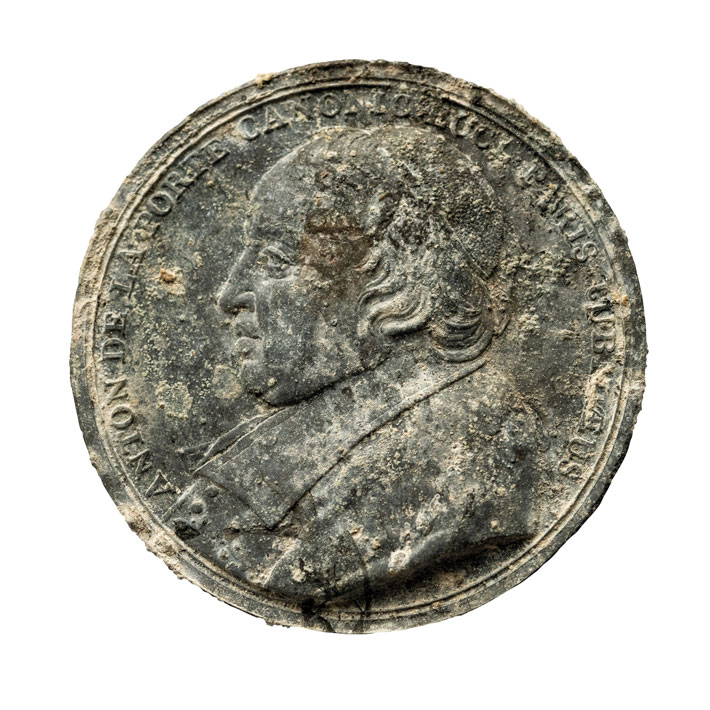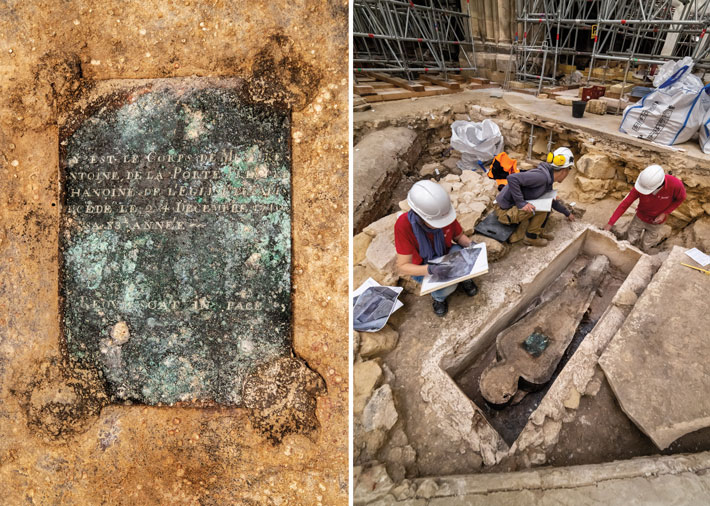Update: Notre Dame’s Nobility
May/June 2023
 While digging beneath the transept of Paris’ Notre Dame Cathedral, archaeologists from the French National Institute of Preventive Archaeological Research (INRAP) recovered two lead sarcophagi. The first was sealed within a masonry tomb in a privileged position at the threshold of the cathedral’s choir. An epitaph identifies the deceased as Antoine de la Porte, a cleric who paid for renovations to the choir and died in 1710 at the age of 83. Three bronze medals depicting de la Porte were found atop the coffin. De la Porte’s polished teeth and slender bones indicate a life of leisure befitting someone of his position. Furthermore, explains biological paleoanthropologist Eric Crubézy of the University of Toulouse III–Paul Sabatier, he has lesions on a big toe that appear to be characteristic of gout. “Because gout is associated with rich food and excessive alcohol consumption,” Crubézy says, “it has been considered a disease of elites.”
While digging beneath the transept of Paris’ Notre Dame Cathedral, archaeologists from the French National Institute of Preventive Archaeological Research (INRAP) recovered two lead sarcophagi. The first was sealed within a masonry tomb in a privileged position at the threshold of the cathedral’s choir. An epitaph identifies the deceased as Antoine de la Porte, a cleric who paid for renovations to the choir and died in 1710 at the age of 83. Three bronze medals depicting de la Porte were found atop the coffin. De la Porte’s polished teeth and slender bones indicate a life of leisure befitting someone of his position. Furthermore, explains biological paleoanthropologist Eric Crubézy of the University of Toulouse III–Paul Sabatier, he has lesions on a big toe that appear to be characteristic of gout. “Because gout is associated with rich food and excessive alcohol consumption,” Crubézy says, “it has been considered a disease of elites.”
 The other coffin, which dates to the sixteenth or seventeenth century, was found west of the transept. “The coffin’s contours sharply follow the shape of the head, shoulders, and hips, which seems to suggest that it was adapted to the deceased’s body,” says INRAP archaeologist Christophe Besnier. The unidentified man died around the age of 30 of chronic tuberculous meningitis. His hip socket shows he rode horses starting in early childhood, and the treatment of his remains further signals his elevated status. “He was embalmed, his thorax opened, and the top of his skull sawed off,” Crubézy says. “Opening the skull and thorax is found only in subjects of the high nobility.”
The other coffin, which dates to the sixteenth or seventeenth century, was found west of the transept. “The coffin’s contours sharply follow the shape of the head, shoulders, and hips, which seems to suggest that it was adapted to the deceased’s body,” says INRAP archaeologist Christophe Besnier. The unidentified man died around the age of 30 of chronic tuberculous meningitis. His hip socket shows he rode horses starting in early childhood, and the treatment of his remains further signals his elevated status. “He was embalmed, his thorax opened, and the top of his skull sawed off,” Crubézy says. “Opening the skull and thorax is found only in subjects of the high nobility.”
To read more about excavations in Notre Dame, go to "Exploring Notre Dame's Hidden Past."
